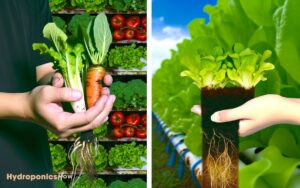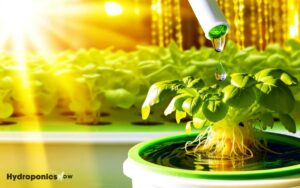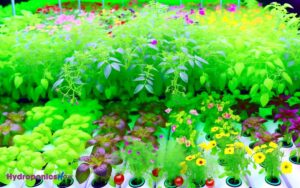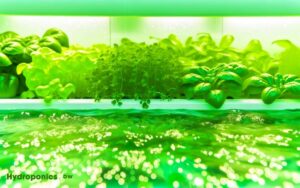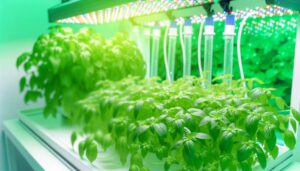Discover 10 Long Tips You Use to Extend Plant Life in Hydroponic Systems
With meticulous care, you can sustain a plant in a hydroponic system for several months to many years. Maintain essential light, temperature, and humidity conditions.
Regularly monitor pH and electrical conductivity to uphold nutrient balance. Replace nutrient solutions weekly and flush with clean water to prevent salt buildup.
Monitor for signs of nutrient deficiency, root rot, and algae growth. Consistent environmental control and rigorous maintenance practices are vital. If plants show yellowing leaves or stunted growth, address nutrient imbalances immediately.
Following these guidelines can greatly extend your plant’s lifespan, offering more insights and results from your hydroponic setup.
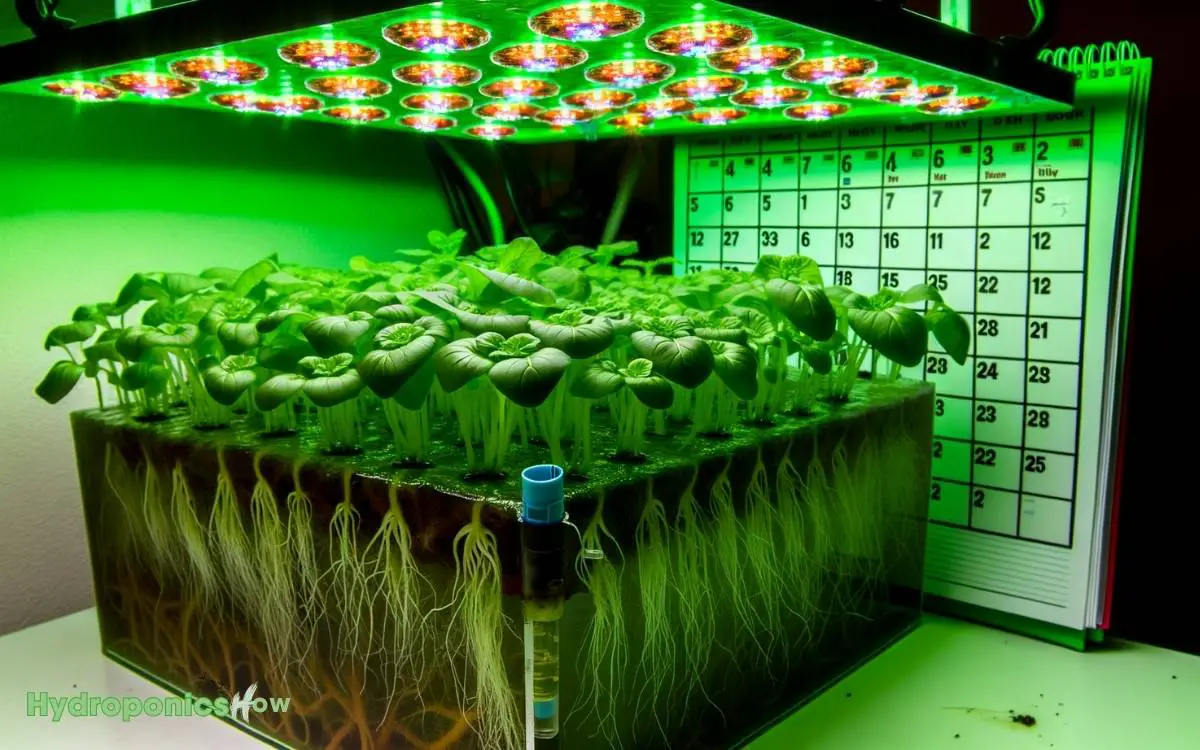
Key Takeaways
Types of Hydroponic Systems
When exploring hydroponics, you’ll encounter several types of systems, each with unique mechanisms and benefits.
The most common systems include Nutrient Film Technique (NFT), Deep Water Culture (DWC), and Ebb and Flow.
In NFT, a thin film of nutrient solution flows over the roots, providing constant access to nutrients and oxygen.
DWC suspends plant roots in oxygenated nutrient-rich water, promoting rapid growth.
Ebb and Flow periodically floods the root zone with nutrients and then drains it, mimicking natural watering cycles.
Each system has precise requirements for nutrient delivery, oxygenation, and maintenance, ensuring peak plant health.
Understanding these systems’ intricacies helps you select the best option for your specific needs and maximize your hydroponic garden’s efficiency and productivity.
Plant Varieties in Hydroponics
Selecting the right plant varieties for hydroponics is essential for optimizing growth and yield in your system. Choosing plants that thrive in a soil-free environment, such as leafy greens, herbs, and certain fruiting crops, ensures better adaptability and success. One of the top benefits of hydroponics is the ability to control nutrients and water intake precisely, leading to faster growth and higher yields. Additionally, disease and pest risks are significantly reduced, making hydroponic systems a more efficient and sustainable option for cultivation.
Leafy greens like lettuce, spinach, and kale thrive due to their fast growth cycles and minimal space requirements. Herbs such as basil, mint, and cilantro also perform exceptionally well.
For fruiting plants, tomatoes, cucumbers, and peppers are popular choices, but they need more attention to nutrient balance and light. Strawberries and certain dwarf varieties of fruit trees can be successfully grown too.
Research the specific requirements of each plant type, including pH preferences, light intensity, and nutrient needs. By choosing suitable varieties, you can maximize efficiency and productivity in your hydroponic setup, ensuring a robust and continuous harvest.
Nutrient Solutions and Lifespan
Understanding the intricacies of nutrient solutions is essential for extending the lifespan and vitality of plants in a hydroponic system. You need to make sure that the nutrient solution has the right balance of macro and micronutrients.
Regular monitoring of pH levels, typically between 5.5 and 6.5, is important for nutrient uptake. Use a conductivity meter to measure the electrical conductivity (EC) of your solution, keeping it within the ideal range for your specific plant species.
Replace the nutrient solution every two weeks to prevent nutrient imbalances and pathogen buildup. Additionally, periodic flushing with clean water helps to eliminate salt accumulation.
Environmental Factors
You must manage environmental factors to maximize the lifespan of hydroponic plants.
Guarantee ideal light conditions, regulate temperature and humidity, and maintain high-quality nutrient solutions. These factors are crucial for plant health and longevity in hydroponic systems.
Optimal Light Conditions
Proper light conditions, including intensity and duration, are essential for maximizing the growth and longevity of hydroponic plants. You’ll need to make sure your plants receive the right type of light spectrum—red, blue, and full-spectrum light are common.
Blue light promotes vegetative growth, while red light encourages flowering. The duration of light exposure, typically 14-16 hours for most plants, also plays a pivotal role.
| Light Type | Purpose | Duration (hrs/day) |
|---|---|---|
| Blue Light | Vegetative Growth | 14-16 |
| Red Light | Flowering | 12-14 |
| Full-Spectrum | Overall Growth | 14-16 |
| LED | Energy Efficiency | 14-16 |
| Fluorescent | Seed Starting | 14-16 |
Adjust the light intensity based on plant type and growth stage, ensuring ideal photosynthesis and overall health.
Temperature and Humidity Control
Maintaining precise temperature and humidity levels is essential for optimizing the growth and health of hydroponic plants.
You should aim for a temperature range of 65-75°F (18-24°C) to guarantee robust plant development. Temperatures outside this range can stress plants and hinder nutrient uptake.
Humidity levels should be kept between 40-60% to prevent fungal growth and encourage efficient transpiration. Utilize digital thermometers and hygrometers to monitor these parameters closely. Implement fans, heaters, or air conditioners to sustain ideal conditions.
Research indicates that consistent environmental control can prolong the productive lifespan of hydroponic plants. By sustaining these conditions, you’ll minimize stress and disease, ensuring your plants thrive and produce for an extended period.
Nutrient Solution Quality
Consistently monitoring the nutrient solution’s quality is crucial for the longevity and health of hydroponic plants. You should regularly check the pH level, making sure it stays within the ideal range of 5.5 to 6.5. A digital pH meter can provide precise readings.
Additionally, measure the electrical conductivity (EC) to gauge nutrient concentration. It’s important to maintain EC levels appropriate for the specific plants you’re growing, as imbalances can lead to nutrient deficiencies or toxicities.
Replace the nutrient solution every two to three weeks to prevent buildup of unwanted salts and contaminants. Also, ensure the solution’s temperature stays between 65-75°F for optimal nutrient uptake.
Common Issues to Watch
When using hydroponics, you’ll often encounter issues such as nutrient imbalances, root rot, and algae growth.
Nutrient imbalances can stunt plant growth and cause deficiencies or toxicities. Monitor EC (electrical conductivity) and pH levels regularly to guarantee ideal nutrient uptake.
Root rot, typically caused by waterborne pathogens, results from poor oxygenation or overwatering. Ensure adequate aeration and maintain proper water temperatures to prevent this issue.
Algae growth, fostered by light exposure to nutrient solutions, competes with your plants for resources. Use opaque containers and cover any exposed water surfaces to limit light penetration.
Addressing these common issues promptly can greatly extend the viability of your hydroponic plants and improve overall system performance.
Maintenance Best Practices
To guarantee the longevity and health of your hydroponic plants, implement rigorous maintenance best practices that focus on peak system performance.
Incorporating these steps into your routine will maximize plant health, yield, and lifespan, ensuring your hydroponic system runs efficiently and effectively.
- Nutrient Balance: Test and adjust the nutrient solution weekly.
- pH Levels: Monitor and correct pH levels daily.
- System Cleanliness: Clean reservoirs, tubing, and growing trays monthly.
Signs of Plant Decline
Early detection of plant decline in a hydroponic system hinges on recognizing key symptoms such as yellowing leaves, stunted growth, and root discoloration.
Yellowing leaves often indicate nutrient deficiencies, particularly nitrogen, while stunted growth could signal inadequate light or imbalanced pH levels.
Root discoloration, typically brown or black, suggests root rot or fungal infections, which can rapidly deteriorate plant health. Monitoring these symptoms allows you to diagnose and address issues promptly.
Ensuring consistent nutrient solution quality, proper aeration, and maintaining ideal environmental conditions are crucial for preventing decline.
By staying vigilant and responsive to these signs, you can maintain your plants’ health longer and maximize their productivity in your hydroponic system.
Extending Plant Lifespan
To extend your plant’s lifespan in hydroponics, you need to focus on maintaining a balanced nutrient mix, implement rigorous disease prevention strategies, and conduct regular pruning and maintenance.
Accurate nutrient formulations tailored to each growth stage promote strong development. Regular health checks and timely interventions prevent disease outbreaks, while systematic pruning promotes continued health.
Optimal Nutrient Balance
Guaranteeing a balanced nutrient mix is essential for extending the lifespan of hydroponic plants, as it directly impacts their growth, health, and productivity.
You’ll want to focus on providing the right amounts of macronutrients and micronutrients.
Here’s a quick guide to optimize nutrient balance:
- Macronutrients: Assure an adequate supply of nitrogen (N), phosphorus (P), and potassium (K). These are critical for plant growth and development.
- Micronutrients: Don’t neglect essential elements like iron (Fe), manganese (Mn), and zinc (Zn). Even in small amounts, they play a pivotal role in plant health.
- pH Levels: Sustain a pH level between 5.5 and 6.5. This range ensures nutrient availability and absorption, preventing deficiencies and toxicities.
Disease Prevention Strategies
Maintaining a clean and sterile hydroponic system is crucial in preventing diseases that can drastically shorten your plants’ lifespan.
- First, regularly disinfect all components, including reservoirs, pumps, and tubing, using a mild bleach solution. This practice eliminates potential pathogens.
- Next, guarantee proper air circulation and humidity control to prevent mold and mildew growth. Use fans and dehumidifiers as needed.
- Monitor water quality closely; pathogens thrive in stagnant water. Consider using UV sterilizers or ozonizers to kill bacteria and algae.
Implementing biological controls, like beneficial microbes, can outcompete harmful pathogens.
Pruning and Maintenance
Pruning and regular maintenance are crucial for maximizing the longevity and productivity of your hydroponic plants. By routinely trimming and caring for your plants, you can prevent diseases, promote better airflow, and enhance nutrient absorption.
Here are three key steps to follow:
- Remove Dead or Yellowing Leaves: Cutting away unhealthy leaves helps guarantee the plant doesn’t waste energy on non-productive parts and reduces the risk of disease.
- Trim Excess Growth: Regularly cutting back overgrown branches encourages new growth and ensures the plant maintains an ideal shape for efficient nutrient uptake.
- Clean and Sterilize Tools: Always use sterilized tools to prevent introducing pathogens that can harm your plants and shorten their lifespan.
Consistent pruning and maintenance help your hydroponic system thrive.
Harvesting Tips
To maximize yield and guarantee plant health, observe the growth cycle and harvest your hydroponic plants at their peak maturity. Monitor the plant’s visual cues such as leaf color, size, and the development of flowers or fruits.
Utilize tools like magnifying glasses to inspect trichomes on plants like cannabis for the best harvest timing.
Make sure you’re familiar with the specific harvest periods of each plant type; leafy greens often require less time compared to fruiting plants. Use sterilized tools for cutting to prevent disease.
Post-harvest, immediately place the produce in appropriate storage conditions to maintain freshness. By following these evidence-based harvesting tips, you’ll achieve superior quality and prolong the productive lifespan of your hydroponic plants.
Long-Term Sustainability
To guarantee long-term sustainability in hydroponics, you must manage the nutrient solution meticulously, monitor root health consistently, and control light and temperature precisely.
Regularly adjusting nutrient levels prevents deficiencies and toxicities. Additionally, maintaining ideal environmental conditions and keeping a close watch on root health can greatly extend the lifespan of your plants.
Nutrient Solution Management
Effective nutrient solution management is crucial for guaranteeing the long-term sustainability of your hydroponic system. You need to maintain a balanced nutrient mix for ideal plant growth.
Here’s how:
- Monitor pH Levels: Regularly check and adjust pH to keep it between 5.5 and 6.5. This range ensures nutrient availability.
- Replace Nutrient Solution: Change the solution every two to three weeks to prevent nutrient imbalances and pathogen buildup.
- Use Quality Nutrients: Invest in high-quality, hydroponic-specific nutrients that provide essential macronutrients and micronutrients.
Root Health Monitoring
Maintaining peak root health is crucial for the long-term sustainability of your hydroponic plants. You should regularly check for signs of root rot, discoloration, and abnormal growth.
Implement a routine to inspect roots visually and use tools like dissolved oxygen meters to guarantee roots are well-aerated. High oxygen levels in the nutrient solution prevent anaerobic conditions that lead to diseases.
Keep the nutrient solution clean and at a preferred pH (5.5-6.5) to promote healthy root development. Beneficial microbes can be introduced to outcompete harmful pathogens. Utilize root zone temperature monitors to ensure stability, as extreme fluctuations can stress roots.
Regular monitoring and immediate corrective actions will sustain root health, ensuring your hydroponic system’s longevity.
Light and Temperature Control
Proper light intensity and temperature control are crucial for maximizing the long-term growth and productivity of your hydroponic plants. Consistent light exposure guarantees that plants undergo effective photosynthesis, while stable temperatures prevent stress.
Here’s how to achieve this:
- Light Intensity: Use LED grow lights with adjustable spectrums to replicate natural sunlight. Maintain 14-16 hours of light per day for most vegetables.
- Temperature Range: Keep air temperatures between 65-75°F (18-24°C). Water temperature should stay within 65-70°F (18-21°C) to avoid root diseases.
- Monitoring Systems: Invest in automated systems for continuous monitoring and adjustments. This guarantees ideal conditions without manual intervention.
Conclusion
In hydroponics, your plants can thrive for months, or even years, with the right care. By attentively managing nutrient solutions, monitoring environmental factors, and addressing common issues promptly, you can extend their lifespan beyond expectations.
Remember, your vigilance is the lifeblood of your hydroponic garden.
With precise, research-based practices, you’ll harvest not just crops, but a bounty of knowledge and sustainability. Keep nurturing, and your garden will flourish like a well-oiled machine, season after season.


